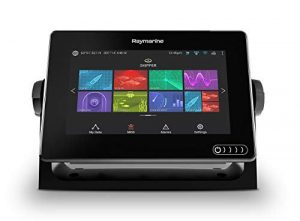 Choosing suitable fishing equipment can be an absolute nightmare. When looking to make a purchase, you have so many options to choose from. For example, if you are looking for a simple line, you are confronted with monofilament, fluorocarbon, or lead core!
Choosing suitable fishing equipment can be an absolute nightmare. When looking to make a purchase, you have so many options to choose from. For example, if you are looking for a simple line, you are confronted with monofilament, fluorocarbon, or lead core!
This choice does not get any easier when looking for a GPS scanner. If you have a budget up to 1000, there is a multitude of scanners to choose. Which manufacturer do you go with? What size screen do you prefer? Is the cone angle important to you? So many considerations! We understand how difficult this can be, but there is a way out!
As luck has it, we can help choose the best fishfinder GPS combo under 1000. We have fantastic knowledge of these devices. We know what features are preferable, and we know what constitutes a quality sonar device. Don’t worry about having to make a difficult decision – if you read the paragraphs below, you can learn from our wisdom. We will share our knowledge with and help you choose a suitable device for your angling adventures!
How to choose best GPS fishfinder combo for the money?
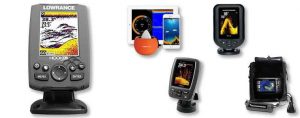
Before we look at the features of an underwater scanner, understand why they are beneficial. Why you need one and how can they help? The below are some key benefits that a scanner provides:
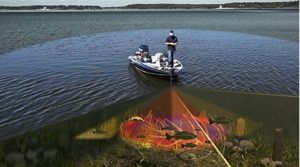 To find fish easier – Obviously, this is the main point of having such a piece of equipment. An underwater scanner is equipped with advanced sonar and radar capabilities. This allows you to see what is in the water below your vessel effectively. If you fish on a regular basis, a locator will help improve your experience and you will have much more fun. Furthermore, you will catch many more fish than usual.
To find fish easier – Obviously, this is the main point of having such a piece of equipment. An underwater scanner is equipped with advanced sonar and radar capabilities. This allows you to see what is in the water below your vessel effectively. If you fish on a regular basis, a locator will help improve your experience and you will have much more fun. Furthermore, you will catch many more fish than usual.
To determine numbers – Fishfinders are best used to search for large schools of marine life. When you are out on the water, you can simply go from spot to spot and bag one or two catches. Using a GPS, you can find where there are huge numbers of fish. You can then maximize your time and stay on one spot for increased efficiency. As with the above, your trip will be more exciting and rewarding.
 To ascertain water depth – When sailing on a lake, river, or even in the open oceans, you have to be wary of the water depth. Even a small lake can have varying depths and seabed that differs by several yards. If you do not know the water depth, you could potentially sail into shallow water and become stuck on the seabed. Moreover, you could potentially crash into rocks and ruin your boat. Furthermore, you can use the depth to uncover what fish are where. Certain species may swim at lower depths, whereas others could stay towards the surface.
To ascertain water depth – When sailing on a lake, river, or even in the open oceans, you have to be wary of the water depth. Even a small lake can have varying depths and seabed that differs by several yards. If you do not know the water depth, you could potentially sail into shallow water and become stuck on the seabed. Moreover, you could potentially crash into rocks and ruin your boat. Furthermore, you can use the depth to uncover what fish are where. Certain species may swim at lower depths, whereas others could stay towards the surface.
To find water temperatures – Water temperature can vary greatly. The base temperature of a lake or river will remain fairly consistent, but it can change depending on the weather and season. Additionally, sea temperatures vary too. Why is this important and how could the best fish finders with GPS help? Simple – the water temperature can affect movement patterns. Different species may prefer warmer water while others prefer the cold. You can analyze the water temperature and become more accurate with your catches.
Saving data for subsequent trips – Most devices allow you to save the scanning data. Let’s say for example, you have travelled to a large lake and found an awesome patch with plenty of catch. You could store the location data, and other statistics using your gadget and refer back the next time you sail on the lake. This is a brilliant advantage of using the best fish finders with GPS.
Choosing the best fishfinder for fishing
Now that you understand the basics of these apparatus, we can look at the features to should look for. These include the transducer, frequency, power, screen resolution, cone angle, and portability:
The fishfinder transducer
 A transducer is what allows the scanner to transmit and obtain sonar waves to display an image. Without a transducer, this device wouldn’t work. A transducer emits sonar waves towards the water bottom. En-route, if the signal hits an object, the radio-waves are bounced back. This is how an image is formed displaying fish and the waterbed.
A transducer is what allows the scanner to transmit and obtain sonar waves to display an image. Without a transducer, this device wouldn’t work. A transducer emits sonar waves towards the water bottom. En-route, if the signal hits an object, the radio-waves are bounced back. This is how an image is formed displaying fish and the waterbed.
Consider the transducer material and how it attaches to your vessel. Most transducers are plastic, but some are made of bronze or steel. The type of transducer depends on the material of your vessel’s hull. For example, a fiberglass hull is suitable for a bronze encased transducer.
Aside from the material, look at the type of transducer and finder. There are three main types – standalone, combination, and networked. Standalone is simply a sonar device, this is the most basic model. Combination models,provide both finding functionality and advanced statistics such as graphs and water temperature. Finally, we have networked models. These are the most expensive and advanced. They connect to other sources via WiFi or Bluetooth to provide live data.
Frequency and Power of fishfinder
Transducers have a frequency and power rating. These are two important features of the model. These features have a significant effect on the quality of your display and the sonar image you will receive. It should also play an important role in the overall usefulness of your fishfinder and the enjoyment of your sailing adventures.
 Frequency – Frequency relates to the cone angle of the transducer sonar waves. A model can have varying frequencies. There are generally three categories of frequency designation – single, dual, and multi. Single frequency accessories only operate on one band while dual frequency devices operate on two different bands. Finally, multi-frequency gadgets operate on a range of frequencies.
Frequency – Frequency relates to the cone angle of the transducer sonar waves. A model can have varying frequencies. There are generally three categories of frequency designation – single, dual, and multi. Single frequency accessories only operate on one band while dual frequency devices operate on two different bands. Finally, multi-frequency gadgets operate on a range of frequencies.
Common frequencies are 50, 192, 83, and 200 kHz. Higher frequencies work best in shallow waters, whereas lower frequencies work best in deeper seas. It is advisable to purchase a finder with multi-frequency capabilities to give you greater versatility. The Hummingbird 410210-1 Helix, for example, can operate at 83, 75-95 and 175-225 kHz.
 Power – Power is measured in Watts. The higher the wattage, the faster your display will show information. The power rating you choose will depend largely on the water you fish in. If you regularly go in shallow waters, a higher power rating is not necessary as less power is needed to fire the sonar waves. Alternatively, if you sail on open seas or deep lakes, a higher power rating is advised. As a general rule of thumb, every 100w of power at 50kHz your transducer will work up to a depth of 400ft. The Lowrance Hook-4 Sonar for example has a power rating up to 500W and can operate at frequencies of 455/800 & 83/200kHz.
Power – Power is measured in Watts. The higher the wattage, the faster your display will show information. The power rating you choose will depend largely on the water you fish in. If you regularly go in shallow waters, a higher power rating is not necessary as less power is needed to fire the sonar waves. Alternatively, if you sail on open seas or deep lakes, a higher power rating is advised. As a general rule of thumb, every 100w of power at 50kHz your transducer will work up to a depth of 400ft. The Lowrance Hook-4 Sonar for example has a power rating up to 500W and can operate at frequencies of 455/800 & 83/200kHz.
Screen resolution of a fishfinder – Color vs. Black & White
Screen resolution and display quality is integral to the quality of the gadget. We’ve looked at the resolution and whether you should purchase a black and white screen. The screen quality determines how clear you can see the scan and potential catches.
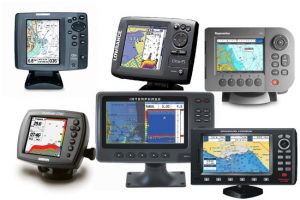 Screen resolution – When we talk about screen resolution, we mean the number of pixels displayed. Digital screens are made from thousands of individual pixels that form together to create an image. The greater the dots per inch (DPI) and size, the more pixels and the higher quality the display. For example, the Hummingbird 698ci has a 640px x 480px resolution which is fantastic. Ideally, you want a screen that is a minimum of 600x400px if not larger.
Screen resolution – When we talk about screen resolution, we mean the number of pixels displayed. Digital screens are made from thousands of individual pixels that form together to create an image. The greater the dots per inch (DPI) and size, the more pixels and the higher quality the display. For example, the Hummingbird 698ci has a 640px x 480px resolution which is fantastic. Ideally, you want a screen that is a minimum of 600x400px if not larger.
The color of the display –There is more to a color screen than just black and white. A color screen can have a different levels of color display. When looking at the screen color, look for DPI and other info. Some screens may only have a limited number of colors available whereas others display a full range of shades, this gives you greater detail and a more realistic picture.
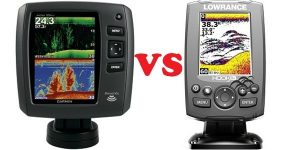 Color vs. Black & White – Some older models still have a black and white display. We strongly advise against this. A color display is much more rewarding. A black and white display is not as high quality, and you will not be able to see as much detail. You can easily obtain a fishfinder under 1000 with a quality color screen.
Color vs. Black & White – Some older models still have a black and white display. We strongly advise against this. A color display is much more rewarding. A black and white display is not as high quality, and you will not be able to see as much detail. You can easily obtain a fishfinder under 1000 with a quality color screen.
Cone angle of fishfinder
 We are not talking about a cone of chips, the cone is the signal arc it creates when scanning. When the gadget scans, it emits a pulse from the underside of your boat/vessel – this forms into a cone shape and gets wider as it gets deeper, Imagine a traffic cone.
We are not talking about a cone of chips, the cone is the signal arc it creates when scanning. When the gadget scans, it emits a pulse from the underside of your boat/vessel – this forms into a cone shape and gets wider as it gets deeper, Imagine a traffic cone.
The angle of a cone relates to how wide it spans from the GPS device. This is important because it denotes how much vision you have when scanning the water. A device with a limited cone and a small angle (for example 6 degrees) will have a narrow field of vision and you will not be able to see great deal. Alternatively, an accessory with a wider cone angle should allow you to see much more. Remember the wider the cone angle, the poorer the quality of the display reading. Ideally, a cone angle between 16 to 20 degrees provides an excellent quality scan. Remember this when purchasing the best fish finder under 1000.
Portable vs. Mountable
Portability must be considered when looking at a device. Portability and location go hand in hand. Which style you buy depends entirely upon the fishing you undertake. Moreover, it will also depend on the vessel you use:
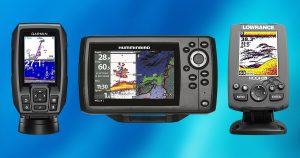
Location – So where do you usually try and land a catch? Do you go out on the open waters? Do you go on streams and rivers? Maybe you go on lakes? For longer trips out into the open sea, the best fish finders with GPS should be mountable as you need stability. Alternatively, if you simply travel on quieter waters for shorter periods, you could use a portable fish finder GPS combo.
Type of vessel – What vessel do you usually travel in? Maybe a simple kayak or canoe? Maybe you sit on the side of a lake in your chair? What about if you take a large sailing boat out to sea? For smaller vessels, there is no need to use a mountable attachment – you can simply store it on your boat. Alternatively, if you are using a large ship, a mountable device is prefered.
Top-10 best fishfinder GPS Combo under 1000
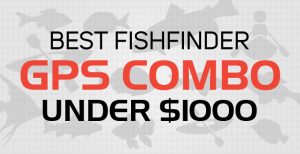
Having the best fishfinder GPS combo under 1000 is a crucial part of the toolkit of any serious fisherman, especially one who is on a budget. Not only is it immeasurably useful to know where the fish you’re hunting are but it is just as useful to know where they were since this will give you an idea of the shape of their path through the water. With this knowledge, you can make reasonable guesses about where they will be, making it all the easier to get the drop on them and catch them. Not only this but if you spend an extended amount of time on the open water away from any landmarks, having a GPS makes orienting yourself far easier.
For your benefit and for the sake of your wallet, we’ve compiled a list of 10 of the best fishfinder GPS combos for under 1000. Like a GPS we hope to be able to orient you in this world and let you know which of these devices are best and can maximize your chances of catching a lot of fish.
Raymarine Dragonfly 7 Pro CHIRP Fish Finder with built-in GPS and WiFi – Best Fishfinder GPS Combo Under 1000
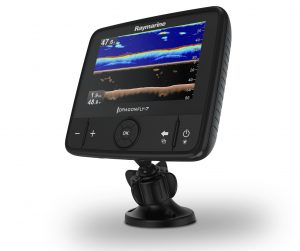 Raymarine’s Dragonfly 7 Pro is an excellently designed unit that can provide detailed maps of a lake bed at depths running up to an impressive 600 feet. To round out its versatility and wide range of applicability, it comes with a set of Navonics+ charts that cover an extraordinary 20,000 lakes, ensuring no matter where you are, you can be confident in having accurate GPS results. Though this will cost you a bit more money, to the serious fisherman, it’s well worth it. Other notable features include:
Raymarine’s Dragonfly 7 Pro is an excellently designed unit that can provide detailed maps of a lake bed at depths running up to an impressive 600 feet. To round out its versatility and wide range of applicability, it comes with a set of Navonics+ charts that cover an extraordinary 20,000 lakes, ensuring no matter where you are, you can be confident in having accurate GPS results. Though this will cost you a bit more money, to the serious fisherman, it’s well worth it. Other notable features include:
- Transducer: Includes a Dragonfly CPT-DVS transom mount transducer, which uses both CHIRP and DownVision.
- Frequency: 80 kHz to 240 kHz.
- Power: Uses a battery. Charger included.
- Screen: 7 inches.
- Cone Angles: 25 degrees for CHIRP and 60 degrees for DownVision.
- Type (portable or mountable): Mountable.
Pros:
- has both CHIRP sonar and DownVision, allowing for accurate readings in both deep and shallow water
- provides very detailed readings of lake beds
- comes with a set of 20,000 lake maps included
- conveniently mountable
- can connect to your phone and display images with WiFi
Cons:
- no backlight on the buttons, so it’s hard to use it in the dark
- software not upgradeable
Verdict: All in all, this is an excellent and versatile unit that it’s hard to go wrong with. It’s a mix of convenience and versatility lead us to recommend it without reservation.
Check on AmazonGarmin Striker 4 with Transducer, GPS Fishfinder – Top-Rated Fish Finders With GPS Under 1000
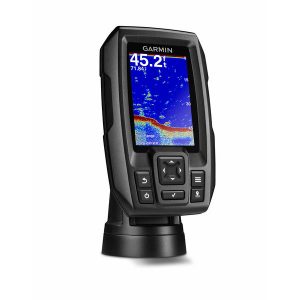 All fishermen who are on a budget would do well to seriously consider this model. Garmin is an industry leader among GPS devices and has a special knack for producing top rated fish finders with GPS, so it offers something for everyone. This device in particular allows you to mark and save up to 5,000 spots and is small, convenient, and portable. Some important features include:
All fishermen who are on a budget would do well to seriously consider this model. Garmin is an industry leader among GPS devices and has a special knack for producing top rated fish finders with GPS, so it offers something for everyone. This device in particular allows you to mark and save up to 5,000 spots and is small, convenient, and portable. Some important features include:
- Transducer: 010-10249-20 CHIRP transducer with 77 and 200 kHz.
- Frequency: 200 kHz and 77 kHz.
- Power: Uses a battery. Charger included.
- Screen: 3.5 inches.
- Cone Angles: 15 degrees at 200 kHz and 45 degrees at 77 kHz.
- Type (portable or mountable): Mountable.
Pros:
- very cheap
- penetration depth of up to 1,600 feet for freshwater and 750 feet for saltwater
- great for use on small boats
Cons:
- only capable of mid and high CHIRP
- does not provide latitude and longitude information
- very small screen
Verdict: If the only features you require are a small, affordable fishfinder and you don’t feel the need to put money down for DownView sonar or any fancier navigation features, this is definitely a unit that you should consider. While it may not be the best Garmin fishfinder GPS combo, considering the low price, it does have the basics covered.
Check on AmazonHumminbird 409850-1 Helix 7 – Best Humminbird GPS Fishfinder Combo
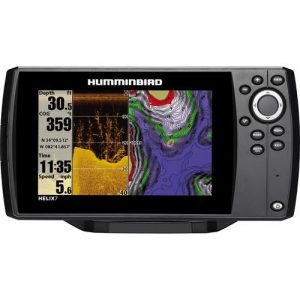 Humminbird has been able to produce quite a few top-rated fish finders with GPS over the course of its history. This unit in particular features both GPS chart-plottng and track-plotting. It also allows you to save up to 2,500 waypoints, 45 routes and as many as 20,000 points that you can return to later. Other critical features include:
Humminbird has been able to produce quite a few top-rated fish finders with GPS over the course of its history. This unit in particular features both GPS chart-plottng and track-plotting. It also allows you to save up to 2,500 waypoints, 45 routes and as many as 20,000 points that you can return to later. Other critical features include:
- Transducer: XNT 9 SI 180 T Transom transducer.
- Frequency: 83, 200 and 455 kHz.
- Power: Compatible with a 10.8 – 20V DC battery.
- Screen: 7 inch screen (diagonal).
- Cone Angles: 20 degrees (for 200 and 455 kHz) and 60 degrees (for 83 kHz).
- Type (portable or mountable): Mountable.
Pros:
- has an impressive array of GPS features
- charts can be upgraded with software
- 600-foot depth capability (but can be up to 1,500 feet with XD transducer)
Cons:
- expensive
Verdict: This Humminbird fish finder with GPS is a fine unit overall, with excellent sonar and side view capabilities, but the price is quite high compared to most other units we discuss here. Cheaper alternatives are available.
Check on AmazonGarmin Echomap Chirp 74SV With Transducer – Top-Rated Garmin Fishfinder With GPS
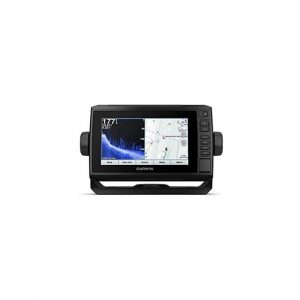 Potential buyers should be aware this particular Garmin GPS and fishfinder combo has been discontinued by the manufacturer. Although this is a pretty good unit, featuring extensive sonar and GPS capabilities, and comes preloaded with a large set of maps from BlueChart g2, it would probably be more convenient for most buyers to seek out a newer version of Garmin’s Echomap 74SV. Just in case,some of the important features include:
Potential buyers should be aware this particular Garmin GPS and fishfinder combo has been discontinued by the manufacturer. Although this is a pretty good unit, featuring extensive sonar and GPS capabilities, and comes preloaded with a large set of maps from BlueChart g2, it would probably be more convenient for most buyers to seek out a newer version of Garmin’s Echomap 74SV. Just in case,some of the important features include:
- Transducer: GT51M-TM (12-pin).
- Frequency: 80-16 kHz (CHIRP), 245-275 and 445-465 kHz (ClearVü and SideVü).
- Power: Uses a battery. Charger included.
- Screen: 7 inches.
- Cone Angles: 13 – 24 degrees (CHIRP), 2 – 51 and 1 – 29 degrees ClearVü and SideVü).
- Type (portable or mountable): Mountable.
Pros:
- clear screen and easy-to-use interface
- comes preloaded with a large set of maps
- has an excellent transducer with a broad range of capabilities, including CHIRP, ClearVü, and SideVü
Cons:
- discontinued by the manufacturer and therefore harder to find
Verdict: Since this model has been discontinued, it would probably be much easier to go ahead and try to find a new model from Garmin. Although this is a fine model, newer models typically have improved features and getting a newer one would result in less overall hassle.
Check on AmazonLowrance Elite-7 Fish Finder with TotalScan Transducer – Best Lowrance Fishfinder GPS Combo Under 1000
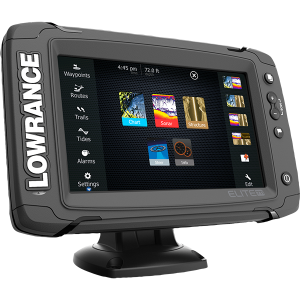 This Lowrance GPS sonar combo is an excellent product for fishermen looking to go fishing, especially in deep waters, as it offers some rather astounding capabilities to provide accurate images and maps of the depth. It also includes Fish ID technology to tell you what sort of fish the device has found, temperature graphs, a DownScan overlay that gives you a 2D rendering of DownScan results, and several alarms. Other important features include:
This Lowrance GPS sonar combo is an excellent product for fishermen looking to go fishing, especially in deep waters, as it offers some rather astounding capabilities to provide accurate images and maps of the depth. It also includes Fish ID technology to tell you what sort of fish the device has found, temperature graphs, a DownScan overlay that gives you a 2D rendering of DownScan results, and several alarms. Other important features include:
- Transducer: TotalScan transom mount transducer, number 000-12568-001. Includes CHIRP, SideScan, and DownScan.
- Frequency: 50, 83 and 200 kHz for CHIRP and 455 and 800 kHz for SideScan and DownScan.
- Power: 12V DC battery. Charger included.
- Screen: 7 inches (touchscreen).
- Cone Angles: 20 degrees for 200 kHz and 60 degrees for 83 kHz.
- Type (portable or mountable): Mountable.
Pros:
- WiFi and Bluetooth connectivity
- depth capability up to 3,000 feet
- excellent on-screen readability and clear presentation
- compatible with many chart and map packs
Cons:
- touchscreen is difficult to use if your hands get wet while fishing
- manual is not very detailed
- on the expensive side
Verdict: A number of reviews have kept this from being the best rated fish finder GPS combo available, but the Bluetooth capability is extraordinarily useful. Only buy this if you are willing to shell out some extra money. Cheaper models are available that are just as good.
Check on AmazonGarmin GPSMAP 1040xs Chartplotter/Sonar Combo – Good Garmin Fishfinder GPS Combo Under 1000
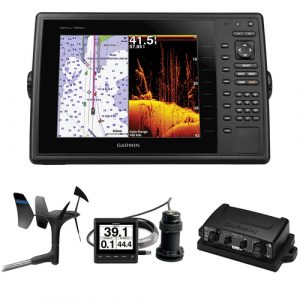 This Garmin fishfinder combo is both a chart plotter and emits sonar. Fishermen who like traveling to different spots will be pleased to know that it comes preloaded with U.S. LakeVu HD and Blue Chart g2 coastal maps, ensuring some of the most detailed readings imaginable. This unit comes with an extraordinarily wide range of sonar features and an equally impressive assortment of navigation features, including the ability to calculate your boat’s speed and record up to 5,000 waypoints, 100 routes, and 50 trails using as many as 50,000 trail points. Were it not for the unfortunate fact that it does not come with a transducer, it might easily be the best fish finder GPS combo there is. Other features include:
This Garmin fishfinder combo is both a chart plotter and emits sonar. Fishermen who like traveling to different spots will be pleased to know that it comes preloaded with U.S. LakeVu HD and Blue Chart g2 coastal maps, ensuring some of the most detailed readings imaginable. This unit comes with an extraordinarily wide range of sonar features and an equally impressive assortment of navigation features, including the ability to calculate your boat’s speed and record up to 5,000 waypoints, 100 routes, and 50 trails using as many as 50,000 trail points. Were it not for the unfortunate fact that it does not come with a transducer, it might easily be the best fish finder GPS combo there is. Other features include:
- Transducer: No transducer included.
- Frequency: 50, 77 and 200 kHz (2D sonar); 260, 455 and 600 kHz (ClearVü).
- Power: Uses a 1 kW battery. Charger included.
- Screen: 10.4 inches.
- Cone Angles: Between 12 and 45 degrees for HD-ID and between 30 and 50 degrees for ClearVü, depending on the transducer selected.
- Type (portable or mountable): Portable.
Pros:
- enormous amount if navigation features
- includes both CHIRP and DownVu scanning sonar
- produces amazingly accurate representations of lake beds
- works at great depths (up to 2,700 feet in saltwater)
Cons:
- relatively expensive
- no transducer included
Verdict: Since this unit is expensive compared to other units we have discussed, the fact that it does not come with a transducer weighs heavily against it. Since you’ll have to spend extra on a transducer, only buy this unit if you insist on having nothing but the very best and if you have money to throw around.
Check on AmazonGarmin Striker 7SV with Transducer – Top-Rated Garmin GPS Combo Under 1000
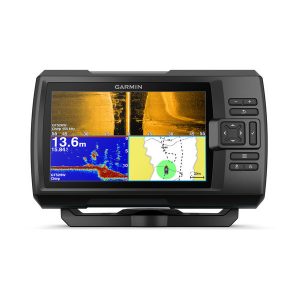 Garmin’s Striker 7SV contains a transducer that emits high-frequency waves that provide you with a tremendously accurate and detailed picture of the surroundings in the water. One special feature of this unit is that with it, you will be able to mark whatever spot you like and then return to it at any future time. Some major features in this Garmin GPS fishfinder include:
Garmin’s Striker 7SV contains a transducer that emits high-frequency waves that provide you with a tremendously accurate and detailed picture of the surroundings in the water. One special feature of this unit is that with it, you will be able to mark whatever spot you like and then return to it at any future time. Some major features in this Garmin GPS fishfinder include:
- Transducer: Includes CV52HW-TM transducer for traditional CHIRP sonar and also for CHIRP ClearVü and CHIRP SideVü scanning sonars.
- Frequency: 150 kHz to 240 kHz (CHIRP Sonar); 455 kHz and 800 kHz (ClearVü and SideVü).
- Power: Uses a battery. Charger included.
- Screen: 7 inches.
- Cone Angles: 25 degrees.
- Type (portable or mountable): Mountable. Comes with a standard mount.
Pros:
- excellent transducer with a wide range of capabilities
- built-in WiFi connectivity
- extremely accurate representations of what is underwater
Cons:
- does not accept any additional mapping software
Verdict: Although this unit has a smaller screen size than some larger units from Garmin, the size is still adequate. The overall product delivers the performance one would expect from an industry leader. One can easily regard it as perhaps the best GPS fishinder so we recommend it.
Check on AmazonRaymarine Dragonfly 4 Pro CHIRP Fish Finder With Built-in GPS and WiFi – Best GPS Fishfinder Under 1000
 This exquisite unit from Raymarine may easily be the best fishing GPS available for the money. With all of the excellent features and much vaunted versatility of Raymarine’s larger Dragonfly models – including both CHIRP sonar and DownVision, as well as an extraordinary assortment of 20,000 maps – this is hands-down the best GPS fish finder combo for those who are on a budget. Other outstanding features include:
This exquisite unit from Raymarine may easily be the best fishing GPS available for the money. With all of the excellent features and much vaunted versatility of Raymarine’s larger Dragonfly models – including both CHIRP sonar and DownVision, as well as an extraordinary assortment of 20,000 maps – this is hands-down the best GPS fish finder combo for those who are on a budget. Other outstanding features include:
- Transducer: Dragonfly CPT-DVS transom mount transducer, which uses both CHIRP and DownVision.
- Frequency: 80 kHz to 240 kHz.
- Power: Uses a battery. Charger included.
- Screen: 4.3 inches.
- Cone Angles: 25 degrees for CHIRP and 60 degrees for DownVision.
- Type (portable or mountable): Mountable.
Pros:
- very inexpensive
- includes both CHIRP and DownVision
- can connect to your phone through WiFi
- comes with a set of 20,000 lake maps
- conveniently mountable
Cons:
- very small screen
- software not upgradeable
- no backlight on the buttons
Verdict: With all the versatility and value of Raymarine’s other Dragonfly models but at only a fraction of the cost, there are no better options than this model if you happen to be budget-conscious. We highly recommend it.
Check on AmazonRaymarine Dragonfly 5 Pro CHIRP Fish Finder With Built-in GPS and WiFi – Best Raymarine GPS Fishfinder Combo in 2019
 This Raymarine GPS fishfinder boasts all of the great features common to other Raymarine models, but at a fairly reduced cost. It also has 20,000 lake bed maps and a sonar that is effective at depths of up to 600 feet with very accurate reading and lake bed reconstruction capabilities to provide you with a very reliable image while fishing. If you’re willing to accept having a 5-inch screen over 7 inches, you’ll have all of the advantages of the larger version, but at less cost. Other features include:
This Raymarine GPS fishfinder boasts all of the great features common to other Raymarine models, but at a fairly reduced cost. It also has 20,000 lake bed maps and a sonar that is effective at depths of up to 600 feet with very accurate reading and lake bed reconstruction capabilities to provide you with a very reliable image while fishing. If you’re willing to accept having a 5-inch screen over 7 inches, you’ll have all of the advantages of the larger version, but at less cost. Other features include:
- Transducer: Dragonfly CPT-DVS transom mount transducer, which uses both CHIRP and DownVision.
- Frequency: 80 kHz to 240 kHz.
- Power: Uses a battery. Charger included.
- Screen: 5 inches.
- Cone Angles: 25 degrees for CHIRP and 60 degrees for DownVision.
- Type (portable or mountable): Mountable.
Pros:
- inexpensive
- includes both CHIRP and DownVision
- can connect to your phone through WiFi
- comes with a set of 20,000 lake maps
- conveniently mountable
Cons:
- small screen
- software not upgradeable
- no backlight on the buttons
Verdict: Any fish finder GPS combo from Raymarine deserve a hearty recommendation. Even though the screen size might be a bit small, the reduced cost of this unit makes up for this and only makes it all the more attractive.
Check on AmazonGarmin Striker Plus 9SV with CV52HW-TM transducer – Garmin GPS Radar Combo Under 1000
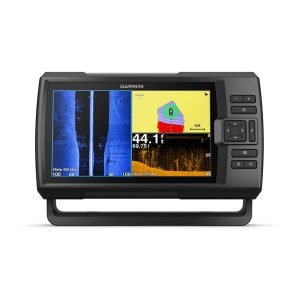 Garmin is a company with a distinguished history of producing high-quality GPS devices of all sorts and it proudly continues that tradition with this unit. In addition to its accurate lake bed mapping technology and high-frequency sonar that helps you reel in the fish that are at or near the surface. This Garmin GPS and fish finder combo also has an accurate “side sweeper” sonar that will give you an excellent view of what is around you. Also, the map on the screen moves along with your boat as you travel. It works best for tracking fish who are relatively near the surface.. Other features include:
Garmin is a company with a distinguished history of producing high-quality GPS devices of all sorts and it proudly continues that tradition with this unit. In addition to its accurate lake bed mapping technology and high-frequency sonar that helps you reel in the fish that are at or near the surface. This Garmin GPS and fish finder combo also has an accurate “side sweeper” sonar that will give you an excellent view of what is around you. Also, the map on the screen moves along with your boat as you travel. It works best for tracking fish who are relatively near the surface.. Other features include:
- Transducer: Includes CV52HW-TM transducer for traditional CHIRP sonar and also for CHIRP ClearVü and CHIRP SideVü scanning sonars.
- Frequency: 150 kHz to 240 kHz (CHIRP Sonar); 455 kHz and 800 kHz (ClearVü and SideVü).
- Power: Uses a battery. Charger included.
- Screen: 9 inches.
- Cone Angles: 25 degrees.
- Type (portable or mountable): Mountable. Comes with a standard mount.
Pros:
- large screen and user-friendly interface
- built-in WiFi connectivity
- excellent transducer with a wide range of capabilities
Cons:
- does not accept any additional mapping software
- is only a fishfinder, not a chart-plotter and fishfinder combo
Verdict: For reeling in fish near the surface, this unit will prepare you better than any other, making it perhaps the best GPS fish finder combo for the money. We recommend it.
Check on AmazonFrequently Asked Questions about GPS fishfinders
 Having a decent selection of the best and most affordable GPS fishfinders is one thing but if you haven’t had much contact with these devices before, you’re likely to have some questions. To round out your understanding and make sure you’re as informed as possible, we’ve decided to answer a few basic questions people tend to have about fishfinders.
Having a decent selection of the best and most affordable GPS fishfinders is one thing but if you haven’t had much contact with these devices before, you’re likely to have some questions. To round out your understanding and make sure you’re as informed as possible, we’ve decided to answer a few basic questions people tend to have about fishfinders.
What is a fishfinder transducer?
A transducer is the device that sends sounds waves out into the body of water you are fishing and then receives back echoes of the signal waves. By receiving back those echoes, it can determine what is beneath the surface of the water and at approximately what depth each object is located. The transducer uses data it receives from the echoes to reconstruct a picture of what things are like underwater, including rock formations and fish. It’s this reconstructed picture that is the basis of what your fishfinder GPS displays for you.
What frequency should I use on my fishfinder?
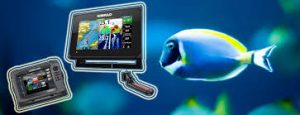
Fishfinders emit a fairly wide range of frequencies depending on their intended use. Usually, these range from 15 kHz to about 200 kHz, though fishinders that emit frequencies outside this range do exist.
As a general rule, high-frequency emissions are useful for reconstructing detailed and specific pictures of what is going on underwater, but become useless at great depths, while low-frequency emissions are useful for general and broad-based searches, or for searches at great depths. The ideal frequency you want to be emitted will depend on where you plan to fish and the depth and details you require.
It may be a good idea for you to first case out an area with low-frequency pulses (~15 kHz) to get an idea of the general location of the school of fish you are after. Then, you can increase those pulses to a higher frequency to pinpoint a fish’s location more precisely.
What is the best fish finder GPS combo under 1000?
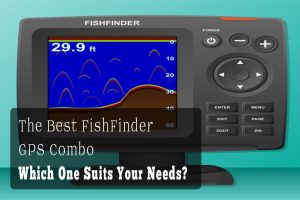 Now that we’ve discussed 10 fantastic units in our bid to help you track down the best fishfinder GPS combo under 1000, we can confidently say we think the Raymarine Dragonfly 7 Pro CHIRP Fish Finder with built-in GPS and WiFi is the best of them all. Offering an extremely useful combination of both CHIRP sonar and DownVision to help you get accurate readings at a wide range of depths, it truly boasts a valuable combination of features. However, since different devices with different combinations of features can work best under different conditions, all the other products we’ve covered deserve a look, including:
Now that we’ve discussed 10 fantastic units in our bid to help you track down the best fishfinder GPS combo under 1000, we can confidently say we think the Raymarine Dragonfly 7 Pro CHIRP Fish Finder with built-in GPS and WiFi is the best of them all. Offering an extremely useful combination of both CHIRP sonar and DownVision to help you get accurate readings at a wide range of depths, it truly boasts a valuable combination of features. However, since different devices with different combinations of features can work best under different conditions, all the other products we’ve covered deserve a look, including:
- the Garmin Striker 4 with Transducer, GPS Fishfinder
- the Humminbird 409850-1 Helix 7
- the Garmin Echomap Chirp 74SV With Transducer
- the Lowrance Elite-7 Fish Finder with TotalScan Transducer
- the Garmin GPSMAP 1040xs Chartplotter/Sonar Combo
- the Garmin Striker 7SV with Transducer
- the Raymarine Dragonfly 4 Pro CHIRP Fish Finder With Built-in GPS and WiFi
- the Raymarine Dragonfly 5 Pro CHIRP Fish Finder With Built-in GPS and WiFi; and
- the Garmin Striker Plus 9SV with CV52HW-TM transducer
They all merit the attention of any serious fisherman. Check them all out and find what works best for you.
With that, we wish you the best of luck in catching as may fish as you possibly can.